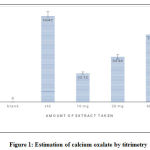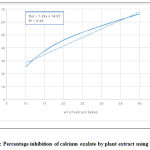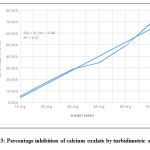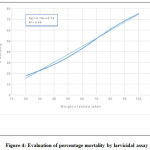Manuscript accepted on :17-04-2021
Published online on: 27-04-2021
Plagiarism Check: Yes
Reviewed by: Dr. Swastika Maity
Second Review by: Dr. B.Surendiran
Final Approval by: Dr Patorn Piromchai
Merin Babu* , Uma K.H
, Uma K.H , Sherin Joseph
, Sherin Joseph , AmoolyaSree
, AmoolyaSree , Sabin Scariya
, Sabin Scariya , Shibina K.A and Jahanara Hameed
, Shibina K.A and Jahanara Hameed
Department of Pharmacology, Amrita School of Pharmacy, Amrita Vishwa Vidyapeetham, AIMS Health sciences Campus, Kochi, Kerala – 682024, India.
Corresponding Author E-mail: merinbabu78@gmail.com
DOI : https://dx.doi.org/10.13005/bpj/2169
Abstract
Objective: Evaluation of Anti-urolithiatic and Larvicidal activity of Alternanthera sessilis. Method: The whole plant of Alternanthera sessilis were extracted using ethanol as solvent. Then it was evaluated for its phytochemicals and later on in vitro anti-urolithiatic study was conducted on the plant using the methods titrimetry, simultaneous flow static model, turbidimetry and gravimetric. The plant showing larvicidal effect was determined by larvicidal assay method. Result: The ethanolic extract of the plant showed the presence of various phytochemicals like phenols, flavonoids, tannins, sterols, saponins. The anti urolithiatic activity conformed that the plant can effectively mineralise calcium oxalate in a dose dependent manner when compared to control and standard. The plant also possesses larvicidal activity and the percentage mortality exhibited a dose dependent manner. Conclusion: The ethanolic extract of the plant possessed anti- urolithiatic as well as larvicidal activity.
Keywords
Antiurolithiatic; Gravimetry; Larvicidal; Phytochemicals; Saponins
Download this article as:| Copy the following to cite this article: Babu M, Uma K. H, Joseph S, Sree A, Scariya S, Shibina K. A, Hameed J. In-Vitro Evaluation of Anti-Urolithiatic and Larvicidal Activity of Alternanthera sessilis. Biomed Pharmacol J 2021;14(2). |
| Copy the following to cite this URL: Babu M, Uma K. H, Joseph S, Sree A, Scariya S, Shibina K. A, Hameed J. In-Vitro Evaluation of Anti-Urolithiatic and Larvicidal Activity of Alternanthera sessilis. Biomed Pharmacol J 2021;14(2). Available from: https://bit.ly/3aMVK23 |
Introduction
Medicine being the science of diagnosing, treating or preventing diseases and damage to the mind or body . A field that goes hand in hand with innovation and in fact being the one that requires remodelling. Today, creating an effective treatment for disease and injuries by building on existing discoveries and knowledge. Medicines along with its new technology have become the antidote for illness and injuries that resulted in their destruction in the entire society. Medicinal plants being used in healthcare system since time immemorial and studies being carried out all over the world in order to verify their efficacy and some of the discoveries have led to the production of plant based medicine. However conscious efforts are always needed to be made to properly find out, recognise and set up medicinal plants in the design and implementation of these strategies. These kind of approach provide interesting and emerging perceptive in the field of medicinal plants. Alternanthera sessilis 1,2,3,12 a widespread herb found throughout the tropics and the subtropics that is either annual or perennial with several spreading branches bearing small petioled leaves with tiny white flowers found mainly ascending to an altitude of 1200 metres in the himalayas, or could be even cultivated as a potherb. This being used in Indian traditional system of medicine in complications due to vitiated blood , skin disease and ulcer its active principle that is usually being extracted in oil were used to treat infected wounds and its nutritive value makes the herb a potent toxic with a wide range of application. Poultice of pounded fresh material is used in sprains burns and eczema whereas a decoction is recommended for wounds, flatulence, nausea, vomiting cough, bronchitis, diarrhea, dysentery and diabetes with its roots being able to relieve inflamed wounds and applied externally on acne and pimples. A sessiles plant has been reported to posses antimicrobial, molluscicidal, moderate anti mutagenic, anti-diarrhoeal, hepato protective cytotoxic and antiviral activities. Phytochemical studies that were done reported the isolation of flavonoids, triterpenoids, steroids and tannins. B-sitosterol, stigmasterol, campsterol, luprol being few of the important constituents. The petroleum ether and benzene extract inhibit the growth of some human and plant pathogenic bacteria. Previous studies showed that that they had hepato protective and potent nootropic activity.
Urolithiasis
The formation of stones in the kidney , bladder or urethra . Stones form twice as often in men than in women The stones formed in the pelvic region cause radiating pain to the groin areas. The stone being mainly composed of calcium oxalate(68.8%) , ammonium phosphate(71.2%) and magnesium. Medical treatment include acute pain management with NSAIDs chronic stone management using thiazide diuretic, potassium sparing diuretic, calcium channel blocker , allopurinol with alkalisation of urine and increase in fluid intake. Phyto,therapeutic agents are alternatives in treating this using different mechanisms such as antimicrobial, anti oxidant diuresis with increased urinary citrate excretion. In vitro and in vivo analyses are performed on medicinal plants for their urolithiatic property. A normal range of uric acid being 250-750 mg per 24 hours in urine, a higher value indicates gout or kidney stones other causes are a diet high in food containing purines.
Larvicidal Activity
In epidemic disease such as malaria, filariasis, dengue etc that are transmitted by mosquitoes vector control is an important aspect. Excessive use of synthetic pesticides causes pesticide resistance and unwanted effects on non targeted organism. These factors have led to an urgent requirement for development of improved mosquito control method that are cheap , feasible as well as safe for non targeted organism and the environment. Herbicidal insecticides become a priority in this matter, some potentially active larvicides of plant origin like falcarinol, geraniol, azadiractin, plumagin, B-sitosterol etc have been isolated so far. In a bioassay of 72 hours with crude plant extracts, the highest mortality was recorded to be 1.5%. A sessiles showed the highest mortality (76.7%) at 1.5 %crude extract against larvae, this activity was in the targeted species (Culex quinquefascioctus). The biological activity of secondary compounds of the plant serves to have greater importance. Studies show saponins as the active component. Saponins being soluble in organic solvents and water, act by associating with cuticle membrane of larvae leading to destructing the membrane, causing larval death.
Material and Methods
Preliminary Phytochemical Screening
The ethanolic extract was treated with various chemical reagents ,for the qualitative analysis of phytoconstituents like alkaloids, glycosides, phenolic components, flavonoids, tannins, saponins, steroids, carbohydrates, terpenoids etc and their respective chemical tests were performed.
In Vitro Anti-Urolithiatic Activity
Evaluation of calcium oxalate by titrimetry4, 5, 6 simultaneous flow static model7,gravimetric assay8 and turbidimetry9, 10 was performed.
Larvicidal Activity11
The percentage mortality of mosquito larvae was evaluated against different concentration of ethanolic extract of A.sessilis. The larvae were considered dead if they settled and remained motionless in the bottom of the container with no response to light or mechanical stimulus.
Results and Discussion
Extraction
Shade dried Alternantherasessilis whole plant wasextracted with ethanol by using soxhlet apparatus and the yield in one extraction was upto 20mg.
Preliminary Phytochemical Screening
Table 1:
| CHEMICAL TESTS FOR ALKALOIDS | |||
| MAYER’S TEST | Two drops of Mayer’s reagent added to few ml of sample solution and formation of white or creamy precipitate, indicates alkaloids. |
– |
|
| WAGNER’S TEST | Few drops of Wagner’s reagent added to few drops of sample, reddish brown precipitate, indicates alkaloids. | ||
| HAGER’S TEST | Add 1or 2 ml of Hager’s reagent to sample solution and formation of prominent reddishorange precipitate, confirmsalkaloids. | ||
| CHEMICAL TEST FOR GLYCOSIDES | |||
| LEGAL’S TEST | Sodium Nitroprusside solution was added to the extract mixed with pyridine to make it alkaline. The change from pink red to red colour indicates cardiac glycosides. |
– |
|
| BALJET’S TEST | 1 ml of sodium picrate solution to few ml of sample and observed for the colour change from yellow to orange, which indicate cardiacglycosides . |
– |
|
| BORNTRAGER’S TEST | Add dilute sulphuric acid to 3 ml of extract,boil and filtered. Add equal volume of benzene or chloroform to the cooled filtrate. Shaken well and add ammonium and observed for the presence of pink, red or violet colour. |
– |
|
| CHEMICAL TESTS FOR PHENOLIC COMPOUNDS | |||
| FERRIC CHLORIDE TEST | To few ml of extract, added 5%ferric chloride,development of violet ,blue or green colour shows the presence of phenolic compounds. | + | |
| LEAD ACETATE TEST | 3 ml of 10% lead acetate solution was added distilled water containing small amount ofextract.Presence of bulky white precipitate indicate phenolic compounds. | + | |
| CHEMICAL IDENTIFICATION OF FLAVONOIDS | |||
| SHINODA TEST | Alcohol added to extract containing few fragments of magnesium turning and concentrated HCl (drop wise), presence of pink or crimson red colour indicates flavonoids. |
+ |
|
| CHEMICAL TEST FOR CARBOHYDRATES | |||
| MOLISCH’S TEST | 2 drops of alcoholic solution of alpha-napthol was added to few ml of extract, shaken well and 1 ml of concentrated H2SO4 slowly added along the side of the test tube and allowed to stand leading to form violet ring at the junction. |
– |
|
| FEHLING’S TEST | Equal amount of fehlings A and fehlings B was added to few ml extract and placed it in a boiling water bath for few minutes. The yellow or brownish red precipitate indicates the presence of reducing sugar. |
– |
|
| BENEDICT’S TEST | 2 ml of benedicts reagent added to few ml sample and mix well. The colour change from blue to green colour was observed while kept in waterbath for 5 minutes indicates reducing
sugar. |
– |
|
| SELIWANOFF’S TEST | To 3ml of seliwanoff test reagent ,added 1ml of sample solution. Boiled in water bath for 2 minutes. Presence of cherry red colour indicates ketose. |
– |
|
| IODINE TEST | To few ml of sample solution, added 4-5 drops of iodine solution and contents were mixed gently. Presence of blue colour indicates polysaccharides. | – | |
| CHEMICAL TEST FOR STEROIDS | |||
| SALKOWSKI
TEST |
To few ml of sample solution, added few ml of chloroform solution and shaken with concentrated sulphuric acid and observed for red colour indicates steroids | + | |
| LIEBERMAN BURCHARD TEST | Few of acetic anhydride added to the chloroform solution of sample and 1ml of concentrated sulphuric acid from the sides were added. The presence of reddish ring at
the junction of two layers indicates steroids |
+ | |
| CHEMICAL TEST FOR TANNINS | |||
| FERRIC CHLORIDE TEST | 1% ferric chloride solution mixed with one ml of sample shows brownish , blue, green colour indicates the presence of tannin. | + | |
| CHEMICAL TEST FOR SAPONINS | |||
| FOAM TEST | Few ml of water mixed with few ml of sample. The foam produced remains for 10 minutes. It confirms saponins. | + | |
| CHEMICAL TEST FOR TERPENOIDS | |||
| 2ml of chloroform was added to extract. Add 3ml of concentrated sulphuric acid carefully producing a layer and reddish brown colouration at the interface indicates terpenoids. | + | ||
(+) indicate presence (-) indicate absence
From the test conducted it was concluded that the plant contain phenolic compounds, flavonoids, steroids, tannins, saponins and terpenoids .
In-Vitroanti-Urolithiatic Activity
Evaluation of calcium oxalate by Titrimetry
Table 2: Estimation of percentage dissolution by titrimetric method.
|
Groups |
Vol. of KMnO4 (ml) |
Weight of calcium oxalate estimated (mg) | Weight of calcium reduced (mg) |
Percentage dissolution |
|
|
Control |
4.7 | 0.89206 | 0 | 0 | |
| 4.5 | 0.8541 | 0 | 0 | ||
| 4.8 | 0.91104 | 0 | 0 | ||
|
Standard Cystone (10 mg) |
1.6 | 0.30368 | 0.58838 | 65.95% | |
| 1.5 | 0.2847 | 0.5694 | 66.66% | ||
| 1.6 | 0.30368 | 0.60736 | 66.66% | ||
|
EEA S |
10
mg |
3.5 | 0.6643 | 0.22776 | 25.53% |
| 3.6 | 0.6833 | 0.1708 | 20.0% | ||
| 3.8 | 0.72124 | 0.1898 | 20.83% | ||
| 20
mg |
2.9 | 0.55042 | 0.34164 | 38.29% | |
| 3.1 | 0.58838 | 0.26572 | 31.11% | ||
| 3.1 | 0.58838 | 0.32266 | 35.41% | ||
|
40 mg |
2.2 | 0.41756 | 0.4745 | 53.19% | |
| 2.2 | 0.41756 | 0.43654 | 51.11% | ||
| 2.3 | 0.43654 | 0.4745 | 52.83% | ||
Table 3: Mean Percentage dissolution and standard deviation by titrimetric method
| SL.NO | GROUP | PERCENTAGE DISSOLUTION OF CALCIUM OXALATE | |
| 1 | CONTROL | 0% | |
| 2 | STANDARD | 66.42±0.004099187 | |
| 3 | EEAS | 10 mg | 22.12±0.029821636 |
| 4 | 20 mg | 34.94±0.036133272 | |
| 5 | 40 mg | 52.38±0.011116354 | |
 |
Figure 1: Estimation of calcium oxalate by titrimetry |
From the study result, it was observed that 40 mg of the plant extract showed the highest percentage dissolution in comparison with other test samples. The standard cystone showed the maximum value of 66.42% and the 40 mg of the plant extract showed 52.38%. The minimum percentage dissolution is exhibited by 10 mg of extract. Hence it can be concluded that the percentage dissolution increases as the concentration increases.
Simultaneous Flow Static Model
Table 4: Percentage inhibition of oxalate crystals by A.sessilis.
|
GROUPS |
WEIGHT OF PPT
( mg) |
PERCENTAGE INHIBITION | |
|
BLANK |
3.53 | 0% | |
| 3.89 | 0% | ||
| 4.02 | 0% | ||
|
STANDARD cystone |
10mg |
1.01 | 71.38% |
| 1.19 | 69.40% | ||
| 1.31 | 67.41% | ||
| EEAS |
10 mg |
2.54 | 28.04% |
| 3.01 | 22.62% | ||
| 3.21 | 24.87% | ||
|
20 mg |
1.87 | 47.02% | |
| 2.11 | 45.75% | ||
| 2.21 | 45.02% | ||
|
40 mg |
1.15 | 67.42% | |
| 1.49 | 69.40% | ||
| 1.51 | 62.24% | ||
Table 4: Mean percentage inhibition and standard deviation by S.S.M
| GROUP | PERCENTAGE INHIBITION | |
| BLANK | 0 | |
| STANDARD (cystone ) | 69.40±0.01985 | |
| EEAAS | 10 mg | 25.18±0.02723 |
| 20 mg | 45.93±0.010121 | |
| 40 mg | 66.35±0.03673 | |
 |
Figure 2: Percentage inhibition of calcium oxalate by plant extract using S.S.M |
From the study result, it was observed that the percentage inhibition is directly proportional to the amount of extract taken. The maximum percentage inhibition of 66.45% was shown by 40 mg of the extract and the minimum inhibition i.e., 25.18% is shown by 10 mg of the extract. The percentage inhibition exhibited by standard cystone was 69.40%
Gravimetry
Table 6: Percentage dissolution of calcium oxalate by gravimetric method
| Weight taken | Weight of undissolved calcium oxalate
(mg) |
Percentage dissolution | |
| Blank | 5.000 mg | 0% | |
| Standard (Cystone) | 10mg | 1.997 mg | 60% |
|
EEAS |
10mg | 4.123 mg | 17.54% |
| 20mg | 3.964 mg | 20.72% | |
| 40mg | 3.621 mg | 27.58% | |
| 60mg | 3.001 mg | 33.22% | |
| 80mg | 2.541 mg | 46.42% | |
| 100mg | 2.254 mg | 54.92% | |
From the result it was seen that the percentage dissolution was linear tothe amount of crude plant extract taken. The maximum dissolution of 54.92% was shown by 100 mg of plant extract and the minimum dissolution of 17.54% exhibited by 10 mg.The standard cystone(10 mg) exhibited 60% dissolution.
Turbidimetry
Table 7: Percentage inhibition of calcium oxalate by turbidimetry Control absorbance: 1.610.
|
AMOUNT TAKEN (mg) |
ABSORBANCE |
PERCENTAGE INHIBITION |
|
|
STANDARD Cystone |
10 mg |
0.276 |
82.85% |
| TEST EXTRACT |
10 mg |
1.524 |
5.34% |
|
20 mg |
1.326 |
17.63% |
|
|
40 mg |
1.142 |
29.06% |
|
|
60 mg |
1.056 |
34.40% |
|
|
80 mg |
0.79 |
49.06% |
|
| 100 mg | 0.491 | 69.50% | |
 |
Figure 3: Percentage inhibition of calcium oxalate by turbidimetric analysis |
The effect of plant extract to various phases of calcium oxalate crystallisation was determined by measurement of turbidity. From the above result it can be concluded that the percentage inhibition was directly proportional to the amount of extract present. The maximum percentage inhibition of 69.50% was shown by 100 mg of plant extract and minimum inhibition of 69.50% was shown by 10 mg of the extract. The standard drug cystone showed a percentage inhibition of 82.85%.
Plant extracts are usually a combination of several phytoconstituents. The plant Alternantherasessilisis a good source of flavonoids, saponins,tannins, sterols, phenolics, triterpenoids. From the entire test conducted to evaluate the anti-urolithiatic potential, it was observed that the plant extract exhibits a dose dependent inhibition. It was already proved that flavonoids show good anticristallo-oxalocalcic activities. Flavonoids reduce oxalocalcic crystallization. According to the work done be Vennila V et al it was proved that saponins are also known to possess anticrystallisation property by disaggregating the suspension of mucoprotiens which are promoters of crystallization. Another study conducted by Anbu J in 2011 proved that triterpenoids also possess antiurolithiatic property. They act by increasing the urine output thus reducing the risk of calcium oxalate super saturation in urine. The phytoconstituents could be the reason for antiurolithiatic action of the plant. Further study need to be conducted to know which of these phytoconstituents contribute more to the antiurolithiatic effect exhibited by the plant.
Larvicidal Activity
Table 8: Evaluation of percentage mortality by plant extract
|
CONC |
TRIAL 1 | TRIAL 2 | TRIAL 3 | MEAN | |||
| No of
dead larvae |
%
mortality |
No of
dead larvae |
%
mort ality |
No of
dead larvae |
%
mortality |
||
| CONTROL | 0 | 0 | 1 | 10 | 1 | 10 | 6.667±5.7735 |
| 20µg/ml of EEAS | 2 | 20 | 3 | 22.2
2 |
2 | 17.7
7 |
17.77±4.800 |
| 40µg/ml
of EEAS |
4 | 40 | 3 | 22.2
2 |
3 | 28.1
4 |
28.14±8.381
5 |
| 60µg/ml of EEAS | 4 | 40 | 5 | 44.4
4 |
5 | 42.9
6 |
42.46±2.093 |
| 80µg/ml of EEAS | 6 | 60 | 6 | 55.5
5 |
7 | 60.7
3 |
60.73±4.565
4 |
| 100µg/m l of EEAS | 7 | 70 | 8 | 77.7
7 |
8 | 75.1
3 |
75.18±3.662
8 |
 |
Figure 4: Evaluation of percentage mortality by larvicidal assay |
The larvicidal action of the plant shows linearity to its concentration. The 100µg/ml concentration showed the highest percentage mortality which was found to be 75.18%. The lowest percentage, 11.11% was shown by the lowest concentration 20μg/ml. The LC50 value was calculated and the concentration was found to be 66.84µg/ ml.
This work demonstrates the effect of Alternantherasessilis on the mosquito larvae. The ethanolic extract of the plant seemed to have concentration dependent effect over the larvae. The presence of phytoconstituentsaponin in the plant lead to the study, it was on an assumption that the presence of saponin in the plant can affect the mortality of larvae. The larvicidal effect of plants with the presence of saponin was studied earlier by BishnuChapagain and ZeevWiesman 2005. Taking these studies into consideration A.sessiliswas evaluated and the plant showed considerable effect when compared with other studies. Saponin molecules interacting with the larval cuticle membrane causes disruption of the membrane, leading to larval death. Further studies have to be conducted to evaluate and confirm whether saponin is responsible for the action and the mechanism involved.
Conclusion
In vitro studies that determine the anti urolithiatic activity and larvicidal activity of alternantheroussessilis was performed .Some constituents like saponins , flavanoids ,tannins ,sterols, phenolic compounds were found after the phytochemical evaluation of the plant. The antiurolithiatic activity was analysed using methods like titrimetic, gravimetric and turbidimetric evaluation. The above constituents could be the reason for the activity of the plant. Positive results were also shown during the preliminary evaluation of larvicidal activity and presence of saponins could be the reason for this. The studies only provide preliminary information of the activity of the plant. Future studies may be conducted to understand the exact mechanism of action of each of these constituents present in the plant.
Acknowledgement
None
Conflict of Interest
The authors declare that they have no competing interest
References
- Subhashini T etal.Anti-inflammatory activity of leaf extracts ofAlternantherasessilis. Hygeia J D Med.2010;2(1):54-56.
- HundiwaleJogendra C etal.A current update on phytopharmacology of the genus Alternanthera. Journal of pharmacy research 2012; 5(4):1924- 1929.
- S Sinha P,Arora VK, Wahi SP, Chemical investigation on Alternantherasessilis,Indian Drug,1,1984,139-40.
- U, Barad R, UpadhyayS,Upadhyay U.Anti urolithiatic activity of Dolichosbiflorusseeds.J.Pharmacogn phytochem.2013; 2(2):209-13.
- SaravanasinghK , Ramamurthy M ,Parthivan P. Invitroantiurolithiatic activity of aerial parts of Aervalanata (L.)Juss.Int.J.curr.Med.Sci.2016; 2(3):24-27.
- Jain M, Bhandari A,Bhandari A ,Patel P. Isolation, characterization and invitroantiurolithiatic activity of crpegin alkaloid from Ceropegiabulbosavar. Lushiroot.Int.J.Drug Dev. and Res.2014;4(4):154-60.
- Sunil Kumar K. N, Suchitra Narayan Prabhu, Ravishankar B, Sahana, B Yashovarma. Chemical analysis and invitro evaluation of anti- urolithiatic activity of Aervalanata(Linn.) Juss. Ex Schult.Roots.JPharmacogn Phytochem.2015;3(3):1-7.
- Benalia, H Djeridane.A ,Bensafieddine, F,Yousfi , M. High invitroanti- urolithiatic effect of Int.J.Pharm.Sci.Res. 2016;1(1):31-43.
- KhareP,Mishra V, Arun K, Bais N ,Singh R. Study on invitroantilithiatic activity of Leaves by homogenous precipitation and turbiditory method. Int J Pharm PharmSci .2014;6(4):124-127.
- Vamsi S ,Raviteja M .,Siva kumar G. In-vitroanti-urolithiatic potential of various extracts of Mucunapruriens.Int Pharm Res .2014;5(9):3897- 902.
- PelahD,Abramovich Z, Markus A ,Wiesman Z .The use of commercial saponin from Quillajasaponariabarksas larvicidal agent against AedesaegyptiandCulexpipiens. J.Ethnopharm.2002;81(3):407-9.
CrossRef - Lalitha Sree T and Dr.K.Vijayalakshmi;Phytochemical screening and quantitative analysis of bioactive components in various extracts of AlternantherasessilisLiLeaves.







